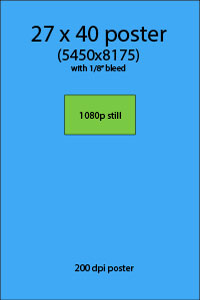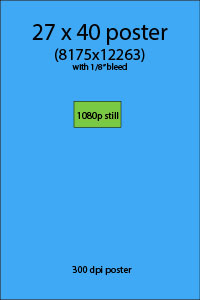By David Averbach
Over the next several days, The Film Collaborative’s Creative Director, David Averbach, who has worked with dozens of TFC Clients and other filmmakers to help them create and refine their key art, will talk about ways you can avoid the problem of finding out all too late that you don’t actually have the proper materials to produce the key art you want to make.
Note: This Key Art series is intended for micro-budget filmmakers whose crew is not under a union contract. If your film’s crew is under an IATSE contract, you will need to abide by the rules regarding still photographers on set as forth by the union. We have been advised that there may be penalties involved by bringing an intern or PA in to shoot stills.
Takeaway: For narrative feature films, understanding the technical aspects of producing key art and thinking ahead to your key art while on your film set can save time, money and a heck of a lot of aggravation down the line.
If I had a nickel for every narrative feature filmmaker who has told me that they got a photographer, professional or otherwise, to come to their film set and shoot photos but in the end they didn’t show up or didn’t do a good job, or was only there for one day out of a sixteen day shoot, and therefore there was nothing to show for that effort in terms of producing images that could be incorporated into a poster, and therefore were only really left with the prospect of using frame grabs from their film, I’d be rich I could probably buy a Starbuck’s gift card that would last me a week or two.
I hope this series of posts can offer some helpful suggestions for you to avoid this situation for your next film.
First let me say that while I design movie posters, I don’t really have a background in filmmaking itself. If there is anything incorrect/inaccurate, generally unfeasible included here, or if you have anything you think I should add, please feel free to let me know. That said, it’s clear to me that in the heat of the film shoot, filmmakers often forget to think about or are so focused on the film shoot that they can’t get around to thinking about the art they might need to support a variety of possible marketing ideas and concepts, and are therefore down the road left with fewer choices and placed in an ultimately weaker position vis à vis possible options on how to market their film or sell it to a potential buyer without an expensive and inconvenient reshoot. (I’m working under the assumption that you are the type of filmmaker who has neither endless funds for a photo shoot 6 months after your shoot ends nor the energy to pull in yet another favor from some photographer you or one of your colleagues may have worked with in the past.)
There are two parts to tackling this problem. The first has to do with understanding resolution: what you have, what you need and how to bridge the two. The second has to do with beginning to think about your marketing strategy even before your film shoot, and preparing to build the raw materials you would need to execute any number of possible marketing directions.
So let’s talk about resolution first. (I’ll get to marketing strategy in Parts 2 and 3 of this series).
Knowing the resolution of your frame grabs
If you’re lucky enough to work with a 4K or 5K camera, such as a RED camera, meaning that the max output resolution is over 5000 pixels wide (5120×2560 on a RED) (which is about 6.5 times that of 1080p (1920×1080), those will produce beautiful film stills. So if you were to shoot your entire film in 5K, much of this next part won’t apply to you. In the real world, according to my DP friend, most people don’t and can’t afford the drive space and rig to do that in production. So if this is the case the highest output for a film grab might still be 1920×1080.
Now 1080p cameras that have a good quality and large sensor with a full chip (DP friend: preferrably not a 1/3 chip), will produce beautiful images…wonderfully clear, and of course you can blow them up to a certain extent without anyone noticing. But if you want your image to take up most of the width of your poster, you will have a resolution problem. The bottom line is, with 1080p output, if you want a theatrical poster using just a few main images, you won’t be able to really rely on frame grabs alone.
While frame grabs will probably work just fine to produce the key art for a DVD cover or a digital release, they are simply not going to cut it for a one sheet. And even while some films will never end up getting a proper theatrical release, all filmmakers tend to want a theatrical (sized) poster, especially if their film gets into a top-tier film festival.
Why won’t frame grabs work well? Well, Bill Clinton said it best: arithmetic.
Perhaps not every filmmaker knows how 1080p correlates to print resolution. As I state above, something that is shot in 1080p (16:9 aspect ratio) is 1920×1080 pixels in dimension. How many pixels will you need for a poster? Well, posters are usually 27×40 plus a ¼” bleed, and the minimum resolution is about 200 dpi (or dots per inch). That means that a poster needs to be at least 5500 pixels wide and that a frame grab would be up-res’d be almost a factor of 3 in order for it to stretch horizontally on a one sheet to even get up to 200dpi.
 |
 |
Until all cameras are 5K resolution and one can easily shoot their whole film this way, part of the collateral damage from the transition to digital is that this is yet one more thing that a filmmaker has to think about…in the days of 35mm, it was common practice to pick a frame of the film and scan it into a large still for use in a poster, but if the maximum output or effective maximum output from your camera is 1080p, you don’t have that luxury.
The end result will produce a blurry image at best and a pixelated image at worst. While this might be good for a background image, if you would like to use a close-up of someone’s face or a full body shot, this is just not going to look good.
Now that we’ve agreed that we need still photographs, what steps can you take to ensure that you will get something that you can use, both in terms of quality and content?
How to make sure you have images for key art — no matter what your budget
You are shooting with a great camera that can take great stills. But what if you can’t spare the time to use the camera you’re shooting on to also do stills?
On to Plan B. Hire a professional photographer, or at least someone with a really nice camera. In an ideal situation, you would get another 5D to take stills to complement the main motion picture camera. (Per my DP friend…Snug up to the lens…use Zeiss prime lenses for sharness or Canon L series lenses if going for more of a softer thing. If you can’t do that with your budget, use a monopod and critically check focus). This is great advice. If you have the budget for it.
But creating images for a poster is more than just producing nice photos. Shadowing the film shoot with a still camera often produces shots that are great for press stills, but may not be all that useful for a poster. Of course it depends on what kind of poster you will want to make. But in the end, it’s good to have a Plan C, and not in the sense that you need a third option because the first two didn’t work. I mean a concurrent Plan C.
This is it: Think of shots for key art as publicity shots, not as enlarged film stills. (And by “publicity shots,” I don’t mean for the actors, I mean publicity shots for the characters, so make sure they stay in character while you shoot them.) It’s fine to do what my DP friend says, but you need to do more. There’s lots of down time on a shoot. Actors are present and in costume and makeup. Move away from the action of the film. Use that hired photographer. Or use hire an intern with a good eye. Use that second 5K camera. Or get an inexpensive 16 megapixel camera. It doesn’t really matter. Just do it. Start outside around lunchtime, when the light is best. Find a white wall, or hang up a sheet outside somewhere. Think about what kind of poster you’d want to make. Develop half a dozen concepts (more on this in parts 2 & 3). Take it seriously. Start shooting.
What you should be creating here is this: Hi-res Scraps. You don’t know how you will use them, but at least you will have something.
Don’t have the budget for a second 5K camera? Fine. But we’ve gotten to a point where consumer cameras can actually produce extremely high quality and high resolution images. Last year, I bought this point-and-shoot camera on Amazon. It’s 16.1 megapixels. It lists right now at $150, but I think I bought it for $109 at one of those after Christmas sales. Every filmmaker has the budget for this much. You’ll be paying a lot more to correct this down the road if you feel this will put your budget over the edge.
See how much more you can get in terms of resolution when using a 16 megapixel camera as compared to a frame grab?
Is this a crappy camera? Compared to the ones you are using to film your shoot, absolutely. But graphic designers have their bag of tricks. Perhaps you’ve heard of Photoshop? We can make even images from these cameras look great. If the right shots are taken. So now there is no excuse to come back from a film shoot empty handed in terms of images for your key art… It is like buying key art insurance: you may not need to use it, but in a pinch you’ll be glad you have it.
Tomorrow, in Part Two, I’ll give you some examples of a few concepts every film should have their “key art still person” shoot.





